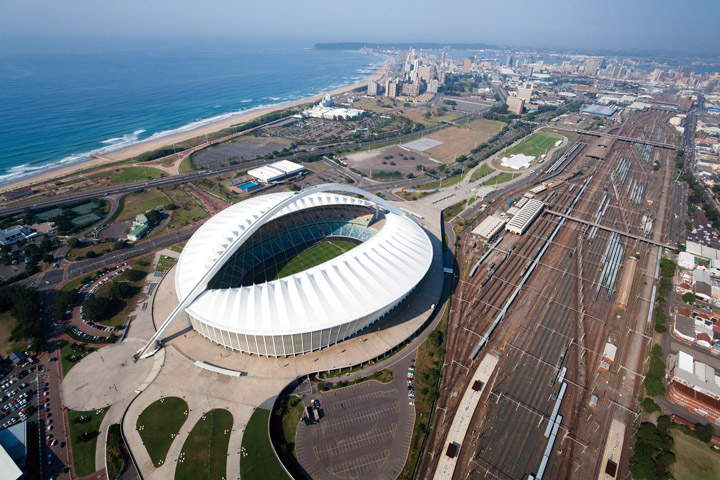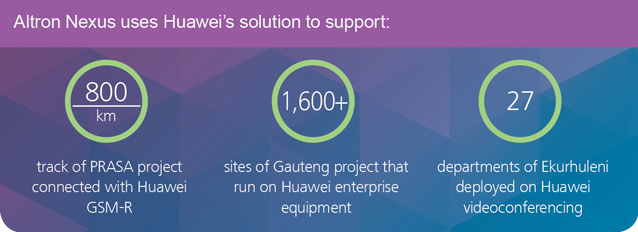Altron Nexus and Huawei: Building a Better Connected South Africa
Продукти, рішення, послуги для організацій

At Altron, we want to help build a better connected South Africa. To achieve this we need to establish solid partnerships that will endure across multiple projects. That’s why we have spent most of the last decade working with Huawei, building multiple broadband networks and solutions for provinces and cities nationwide.
We chose Huawei as a strategic partner because our companies align in terms of our focus on innovation and the comprehensive Information and Communications Technology (ICT) solutions we offer. Our cohesiveness became apparent from the very first project we worked on together, the rollout of a Global System for Mobile Communications-Railway (GSM-R) network, serving South Africa’s passenger railway.
For years, South Africa’s train-to-ground communications system lagged behind those used in many other countries worldwide. Its existing system had been operating for approximately 20 years and could no longer provide secure data communications for the railway dispatch system, other voice services, or new signal systems. Essentially, the communications system was holding the railway network back and limiting its transportation capacity, safety, and efficiency.
In 2011, the Passenger Rail Association of South Africa (PRASA) looked to upgrade all of its railway communications systems. Its aim was to build the most advanced passenger railway system in Africa. With a generous budget of US$15 billion, PRASA sought to create a network on par with that found throughout much of Europe, the GSM-R.
Our company, Altron Nexus, is one of South Africa’s leading ICT integrators. We are a division of Altron TMT, a South African-based ICT solutions company that offers a suite of world-class solutions, ranging from enterprise network services to Smart Industry platforms and Safe City ecosystems. We provide solutions across multiple networks and technologies, covering narrowband, broadband, fixed, and wireless, and we are the largest supplier of critical communications in sub-Saharan Africa. We feel that this is why we won the contract to design and build PRASA’s ambitious new network.
Facing the massive undertaking of providing a network that spans over 2,200 km and more than 150 stations, we wanted to find a world-class vendor to help supply the GSM-R network. Based on its track record of providing high quality and cost-effective transportation transmission, we identified Huawei as a leader in the global ICT industry and a cutting-edge technology provider. This is why we chose Huawei as our partner for the project.
To date, 800 km of track has been connected with Huawei GSM-R, providing mission critical rail operation voice and data functions that enable train drivers, controllers, signaling engineers, and crew members to perform day-to-day operations more reliably and efficiently. The new network also provides communication services to automatic train protection systems, enabling semi-automatic train driving, which further improves the rail network’s safety and reliability.
Following the successful collaboration on the PRASA project, in 2014, we won the bid to build and maintain Gauteng’s Provincial Government broadband network. The project’s goal was to connect all of Gauteng’s local government offices, schools, hospitals, and libraries onto the provincial government owned broadband network, maximizing cost savings through the use of technology.
Given the complexity of the project and the customer’s lack of experience in building and managing networks, it was clear Gauteng needed a service provider that could deliver all the necessary technologies as a complete ‘turnkey’ solution. They needed a solution that could be easily implemented into the government’s existing infrastructure, to protect existing investments. The solution was also required to incorporate design and Build-Operate-Transfer (BOT) capabilities. Based on these requirements, we decided to work with Huawei once again.
We deployed a transport layer network using Huawei enterprise equipment, including Net Engine routers, CloudEngine Core Switches, and the e-Sight management platform, which carries multiple broadband services, including voice, data, and video traffic. Numerous applications and services run on this network, which is currently provided to more than 1,600 sites throughout Gauteng.
As well as these projects, we have also collaborated with Huawei on the City of Ekurhuleni’s public Wi-Fi, deploying a corporate and a public Wi-Fi network covering municipal offices and public facilities within the Ekurhuleni Metro system. The Huawei solution enabled wireless broadband connectivity to provide free public Wi-Fi. Government offices, municipal clinics and libraries were the first locations in which Wi-Fi was deployed, followed by the addition of commercial and residential areas.
To support Ekurhuleni’s 27 departments and public utilities, including access to remote branch offices, Altron Nexus also deployed a Huawei videoconferencing solution. In the past, when city staff had to travel through heavy traffic to attend inter- and intra-departmental meetings their journeys would often be longer than the conferences themselves.
With the new video conferencing solution deployed in all relevant buildings, government departments and public utilities are assured efficient, time and cost saving communications. The solution also integrates into office and business systems to better support the civil services at work in the city.
“Through cooperation with Huawei, Ekurhuleni has deployed city-wide wired and wireless networks, powerful cloud data centers, and government applications,” said Tumelo Kganane, Chief Information Officer of the City of Ekurhuleni. “These are the cornerstones of a Smart City.”
Another major, ongoing project in our partnership is the provincial broadband network for Limpopo province, one of South Africa’s largest provinces, which we are jointly rolling out with Huawei. The goal is to enable connectivity across the entire province by integrating Internet Protocol (IP), and cloud solutions.
The rollout of the Limpopo network will provide the province with open-access, shared, secure, and affordable next generation broadband transmission carrier network. More specifically, we want to connect approximately 6,000 government sites and 1.6 million households by 2030.
From the PRASA project to the current Limpopo project, and multiple others that are ongoing, our partnership has gone from strength to strength, underlined by the fact that we have been Huawei’s leading Value Added Partner (VAP) in South Africa each year since the inception of our relationship. Based on the success of the partnership founded on communication, collaboration, and trust, we intend to continue working with Huawei for many years to come.
